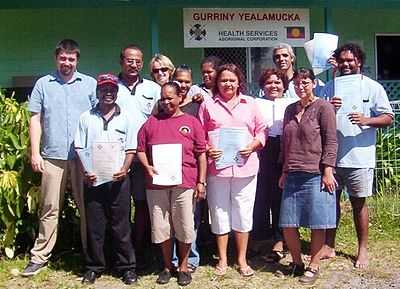Indigenous and Intercultural Health/Case Studies/Social Work
< Indigenous and Intercultural Health < Case Studies
Contributed by Dr Mary Whiteside, Department of Social Work, La Trobe University.
Mary has a long history of involvement in research and development in community settings, including Australian Aboriginal and international contexts.
You are a social worker who is part of a multi disciplinary public health unit in regional Queensland, Australia. In this region Aboriginal and Torres Strait Islander people make up 8%, a proportion higher than other parts of the population. As with elsewhere in Australia, Aboriginal and Torres Strait Islander people in the region experience a higher burden of disease than the general population and your organization believes it should be making this a greater focus of their work.
At a recent staff meeting some alarming state wide statistics were presented. The life expectancy gap is currently estimated at 10.4 years for males and 8.9 years for females.
The six leading drivers of the health gap between Aboriginal and Torres Strait Islander and non-Aboriginal and Torres Strait Islander Queenslanders, which together explain 80% of the health gap:
- Cardiovascular disease – an estimated 28% of the health gap;
- Diabetes – an estimated 16% of the health gap;
- Chronic respiratory disease – an estimated 11% of the health gap;
- Cancers – an estimated 9% of the health gap;
- Injuries - an estimated 8% of the health gap; and
- Mental disorders – an estimated 8% of the health gap.
Cardiovascular disease and diabetes and chronic respiratory diseases are the leading contributors to the health gap in major cities, regional centres and remote areas, together accounting for 55% of the health gap in Queensland.
11 risk factors explain 37.4% of the total burden of disease including:
- Smoking, alcohol and other drugs;
- Obesity, low rates of physical activity and poor nutrition;
- High blood pressure and high cholesterol;
- Unsafe sex; and
- Child
- Sexual abuse and intimate partner violence.
Of these, smoking was the largest cause of health loss, contributing 17% to the health gap and one fifth of all Aboriginal and Torres Strait Islander deaths nationally.
Your team feels overwhelmed by the problems and starts to discuss what they could do. They think they should start with thinking about smoking as a priority, in light of the statistics. Quickly the conversation turned to locating smoking cessation programs that could be run with groups and communities.
This could then lead to two scenarios:
1. An evidence based program is found and imposed on community health centers. A likely outcome is that people don’t turn up and, if they do, there is little if any change is smoking rates (I have an article that would support this outcome).
2. A different process where your team reflects on how they might work with local groups and communities to:
- Build relationships,
- Present and workshop the statistics,
- Consider the linkages between the issues (social determinants),
- Look at what people are attempting to do themselves to address these issues (maybe without much support or funding)
Then, depending on local wishes and priorities:
- Support local initiatives and consider new programs or ways forward (including local capacity building);
- Form research partnerships and seek to build the evidence base around ‘what works’.
Reference
McCalman, J., Cadet James, Y., Harvey, D., Lloyd, J., Minniecon, D., Parr, J., Tsey, K., & Young, D. (2003). Reflecting on Practice – the Development of a Tobacco Brief Intervention Program for Indigenous People in North Queensland. Aboriginal and Islander Health Worker Journal, 27 (2), 23-26.
External Resource: Canadian Social Work Online Learning Module
